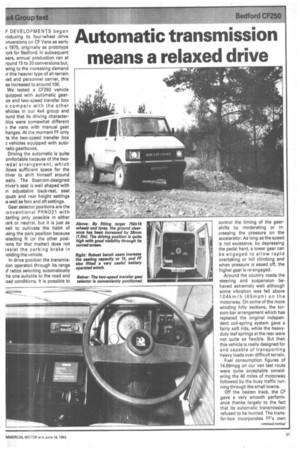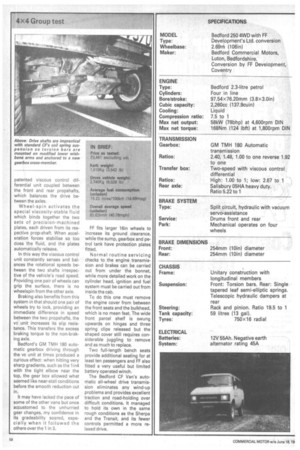Automatic transmission means a relaxed drive
Page 59

Page 60

If you've noticed an error in this article please click here to report it so we can fix it.
F DEVELOPMENTS began roducing its four-wheel drive Dnversions on CF Vans as early s 1975, originally as prototype fork for Bedford. In subsequent ears, annual production ran at round 15 to 20 conversions but, wing to the increasing demand )r this heavier type of all-terrain md and personnel carrier, this' as increased to around 100.
We tested a CF250 vehicle quipped with automatic gearox and two-speed transfer box o compare with the other ehicles in our 4x4 group and Dund that its driving character;tics were somewhat different D the vans with manual gear hanges. At the moment FF only ts the two-speed transfer box
vehicles equipped with autonatic gearboxes.
Driving the automatic is quite omfortable because of the twoiedal arrangement, which illows sufficient space for the !river to shift himself around iasily. The Bostrom-designed Iriver's seat is well shaped with in adjustable back-rest, seat ;quab and rear height settings is well as fore and aft settings.
Gear selector positions are the ;onventional PRND21 with itarting only possible in either mrk or neutral, but it is just as veil to cultivate the habit of ming the park position because ;electing N (or the other posiions for that matter) does not issist the parking brake in iolding the vehicle.
In drive position the transmis;ion operated through its range pf ratios selecting automatically .he one suitable to the road and oad conditions. It is possible to control the timing of the gearshifts by moderating or increasing the pressure on the accelerator. As long as the speed is not excessive, by depressing the pedal hard, a lower gear can be engaged to allow rapid overtaking or hill climbing and when pressure is eased off, the higher gear is re-engaged.
Around the country roads the steering and suspension behaved extremely well although some vibration was felt above 1 0 4km/h (6 5mph) on the motorway. On some of the more winding hilly sections, the torsion-bar arrangement which has replaced the original independent coil-spring system gave a fairly soft ride, while the heavyduty leaf springs at the rear were not quite so flexible. But then this vehicle is really designed for and capable of transporting heavy loads over difficult terrain.
Fuel consumption figures of 14.69mpg on our van test route were quite acceptable considering the 40 miles of motorway followed by the busy traffic running through the small towns.
Off the beaten track, the CF gave a very smooth performance thanks largely to the fact that its automatic transmission refused to be hurried. The transfer-box incorporates FF's own patented viscous control differential unit coupled between the front and rear propshafts, which balances the drive between the axles.
Wheel-spin activates the special viscosity-stable fluid which binds together the two sets of precision-machined plates, each driven from its respective prop-shaft. When acceleration forces stabilise so too does the fluid, and the plates automatically release.
In this way the viscous control unit constantly senses and balances the rotational speeds between the two shafts irrespective of the vehicle's road speed. Providing one pair of wheels can grip the surface, there is no wheelspin from the other axle.
Braking also benefits from this system in that should one pair of wheels try to lock, providing an immediate difference in speed between the two propshafts, the vc unit increases its slip resistance. This transfers the excess braking torque to the non-braking axle.
Bedford's GM TMH 180 automatic gearbox driving through the vc unit at times produced a curious effect: when hitting very sharp gradients, such as the 1in4 with the tight elbow near the top, the gear box allowed what seemed like near-stall conditions before the smooth reduction cut in.
It may have lacked the pace of some of the other vans but once accustomed to the unhurried gear changes, my confidence in its gradeability soared, especially when it followed the others over the 1 in 3. FF fits larger 16in wheels to increase its ground clearance, while the sump, gearbox and petrol tank have protection plates fitted.
Normal routine servicing checks to the engine transmission and brakes can be carried out from under the bonnet, while more detailed work on the cylinder head, ignition and fuel system must be carried out from inside the cab.
To do this one must remove the engine cover from between the front seats and the bulkhead, which is no mean feat. The wide front parcel shelf is swung upwards on hinges and three spring clips released but the shaped cover still requires considerable juggling to remove and as much to replace.
Two full-length bench seats provide additional seating for at least ten passengers and FF also fitted a very useful but limited battery operated winch.
The Bedford CF Van's automatic all-wheel drive transmission eliminates any wind-up problems and provides excellent traction and road-holding over difficult conditions. It managed to hold its own in the same rough conditions as the Sherpa and the Transit, and its fewer controls permitted a more relaxed drive.








































































































